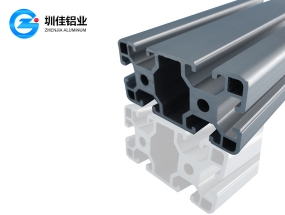The basic extrusion phase of industrial aluminum extrusion, also known as the advection extrusion phase, is the most important stage in the extrusion process of industrial aluminum extrusions. Its stress state and metal flow pattern will have an important influence on the organization, properties and dimensions of the material. Eliminating or reducing the stress non-uniformity in the extruded state and maintaining the metal's reasonable flow is the key to improving the quality of extruded aluminum profile products.
Deformation zone stress state
The external force, stress distribution, and deformation state of the metal in the deformation zone are being squeezed. As can be seen from the figure, the external forces acting on the metal are: the unit pressure σp of the extrusion axis given to the metal through the gasket, the positive pressure dNt, dNz, dNd given to the metal by pressing the barrel wall, the compression cone of the die, and the sizing belt. And frictional stress dτt, dτz, dτd; under certain conditions, there will be frictional stress dτp between gasket and metal.
 When extruding, the stress in the deformation zone is generally in the state of three-direction compressive stress, namely axial compressive stress σ?, radial compressive stress ?r, and circumferential compressive stress ?o. The axial stress σ? and the circumferential compressive stress σo are generated by the pressure acting on the side walls of the squeeze cylinder and the die hole. The deformed state diagrams in the deformation zone are two-direction compression deformation and one-way extension deformation, namely radial compression deformation δr, circumferential compression deformation δo and axial extension deformation δ?.
When extruding, the stress in the deformation zone is generally in the state of three-direction compressive stress, namely axial compressive stress σ?, radial compressive stress ?r, and circumferential compressive stress ?o. The axial stress σ? and the circumferential compressive stress σo are generated by the pressure acting on the side walls of the squeeze cylinder and the die hole. The deformed state diagrams in the deformation zone are two-direction compression deformation and one-way extension deformation, namely radial compression deformation δr, circumferential compression deformation δo and axial extension deformation δ?.
The distribution of the axial principal stress σ? on the gasket is large at the edge and small at the middle (the same distribution as σp). The reason is that the center part of the metal is facing the die hole. According to the minimum resistance law, the deformation resistance is the smallest. The resulting principal stress σ? is also minimal. The distribution of the principal stress σ? along the axis gradually decreases from the shim toward the die hole until the die exit is zero (in the absence of back pressure). The distribution law of radial principal stress σ? is the same as the axial principal stress, except that at the exit of the mold, the value is equal to the deformation resistance Kz at the time of the metal exit from the die.
The relationship between the circumferential principal stress σo and the radial principal stress σr is known from the plasticity theory as an axisymmetric problem, that is, σr=σo. There is actually a slight difference between the two, σr≈σo. The difference increases from the symmetric surface to the surface, and its absolute value is always |σr|>|σo|.
The relationship between the axial principal stress σ? and the radial principal stress σr is not the same in different locations. In the extrusion cylinder part is |σr|>|σo|; in the deformation zone compression cone, |σr|<|σo|, if the influence of the axial tensile stress is not considered. This conclusion can be confirmed by the analysis of the metal flow experiment: the square grid on the specimen in the squeeze tube is flattened, and the grid becomes longer after entering the compression cone in the deformed zone.
During extrusion, the presence of non-uniformity in the flow of metal is unavoidable. This is due to the presence of external friction or the inconsistent temperature distribution of the heated ingot on the cross-section resulting in differences in deformation resistance. Even if neither of the above two conditions exist, it has been mentioned in the foregoing that the metal flow resistance against the die hole is the smallest and the flow velocity is the fastest, so the metal flow is always non-uniform.
Industrial aluminum extrusion process during the external friction is very large, or the outside temperature of the ingot is low, such as the preheating temperature of the extrusion cylinder is not enough, a large temperature gradient is formed between the surface of the heated ingot and the extrusion cylinder, a large number of extrusion cylinder Endothermic, the surface temperature of the ingot has plummeted, so the deformation resistance of the ingot is higher than the central part, resulting in faster internal metal flow and slower external metal flow; but the metal is a whole, metal with fast flow produces metal with slow flow. An axial tension causes additional axial tensile stress on the external metal and additional axial compressive stress on the internal metal. In the cross-section of the ingot, the distribution of the additional tensile stress gradually decreases from the outside to the center, and the additional compressive stress gradually increases from the outside to the center. The distribution of additional stress in the longitudinal section of the ingot increases from the shim to the inlet of the mold and reaches the maximum at the outlet of the compression cone (the cause of this problem will be discussed later). The addition of axial compressive stress and axial compressive stress do not change the stress sign. However, after the additional axial tensile stress and the axial principal compressive stress are superimposed in the outer part of the ingot, the sign of the stress may be changed in the compressive cone part of the deformed zone, so that the axial principal compressive stress becomes a tensile stress and two directions are obtained. Pressure and the principal stress state diagram that has been pulled.
When the ingot heats up, that is, when the outer layer temperature is high and the center temperature is low, the outer velocity portion of the metal flow rate is greater than the center portion, and the opposite result to the above may be obtained, and tensile stress occurs in the center portion of the ingot.


 When extruding, the stress in the deformation zone is generally in the state of three-direction compressive stress, namely axial compressive stress σ?, radial compressive stress ?r, and circumferential compressive stress ?o. The axial stress σ? and the circumferential compressive stress σo are generated by the pressure acting on the side walls of the squeeze cylinder and the die hole. The deformed state diagrams in the deformation zone are two-direction compression deformation and one-way extension deformation, namely radial compression deformation δr, circumferential compression deformation δo and axial extension deformation δ?.
When extruding, the stress in the deformation zone is generally in the state of three-direction compressive stress, namely axial compressive stress σ?, radial compressive stress ?r, and circumferential compressive stress ?o. The axial stress σ? and the circumferential compressive stress σo are generated by the pressure acting on the side walls of the squeeze cylinder and the die hole. The deformed state diagrams in the deformation zone are two-direction compression deformation and one-way extension deformation, namely radial compression deformation δr, circumferential compression deformation δo and axial extension deformation δ?.